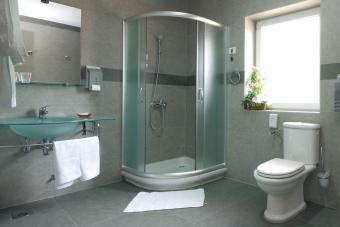
Using bleach to clean bathroom mold is a straightforward solution to a common problem. Mold grows well in damp, warm environments. Your bathroom provides a great habitat for the fungus if you do not keep it clean.
Using Bleach for Cleaning Mold
Mold can be toxic, so it's always a good idea to get a professional opinion before you remediate on your own. If you know your mold is non-toxic and covers an area smaller than three feet wide by three feet tall, it's safe to clean yourself.
How Bleach Works
The main chemical in bleach, sodium hypochlorite, can kill most types of surface indoor mold. Bleach works by killing the mold spores. In the bathroom, mold and mildew can return because of the frequent moisture, so you should make cleaning with bleach a regular part of your household maintenance routine.
Best for Non-Porous Materials
Remember that bleach can only kill mold on the surface of non-porous materials in your bathroom, like a tub, sealed tiles, glass, and certain countertops. If your mold grows on wood trim or ceiling drywall, its roots will take hold inside the porous material where the bleach can't reach. Cleaning these surfaces with bleach will kill the mold you see but won't prevent it from growing again out of the same roots. In this case, the bleach could cause more mold to grow as water from the bleach can reach the pores even though the chemicals can't. If you choose to use it on porous materials, you'll need to thoroughly dry and seal the surfaces after treating them.
How to Use a Bleach Solution in Your Bathroom

To kill the mold, you need to create a bleach water ratio/solution for mold.
- ¾ to 1 cup of bleach to 1 gallon of warm water
- The most bleach you should ever use per gallon of water is one cup.
- Keep this concentration in mind for any application.
General Bathroom Cleaning With Bleach
Wipe down all surfaces with a dry cloth first, then carefully add the bleach mixture to a spray bottle using a funnel.
- Spray down the surfaces with the bleach mixture.
- You can apply the bleach mixture with a sponge or brush for tougher mold or flat surfaces.
- Allow the bleach to sit on the surface for at least five minutes.
- Rinse the bleached area and let it air dry.
How to Clean Shower Mold With Bleach
Do you have a little mold in your shower? Get rid of it fast with a little scrubbing and your bleach solution.
- Spray the shower down with bleach.
- Allow the solution to sit for about 10 or so minutes.
- Scrub down the shower with a cloth.
- Use the toothbrush to scrub any moldy areas.
Moldy Grout

While some warn against the use of bleach on porous surfaces like grout, ServiceMaster suggests it can be used to kill bleach on white grout.
- Create the bleach mixture.
- Use a toothbrush to apply it directly to the grout.
- Let the bleach solution sit for half an hour before rinsing.
- Don't use bleach on colored grout as it can discolor it.
Moldy Caulk
If the caulk around your tub has mold, the best thing is to sterilize it with bleach, just like you would clean grout.
- Add your bleach mixture to a spray bottle.
- Spray down the caulk.
- Scrub with a toothbrush.
- Then you can safely remove the caulk and replace it.
Clean Toilet With Bleach
Most bathroom surfaces only need cleaning once per week, but toilets could use two or more cleanings per week since they are one of the germiest areas.
- Soak the cloth in bleach.
- Wipe it down with a cloth soaked in a bleach solution one time.
- Sanitize the toilet the other time by spraying a bleach solution on it.
- Let the solution dry.
Clean Window Mold
If you've got a window in your shower, you might be able to get rid of mold with a bit of elbow grease, a bleach solution, and some sandpaper.
- Use a nylon brush to scrub the moldy areas on the sill or frame.
- Wipe it with a clean cloth.
If you're working on a painted or unfinished wood surface, you'll want to let it dry completely and sand away the rest of the mold. You'll need to repaint the surface with a good primer and waterproof paint to ensure the mold doesn't come back.
Weekly Maintenance
Once you've used a bleach cleaner on a non-porous surface, it will help prevent mold from growing there in the future. During your weekly bathroom cleaning, spray down the tub and shower with the bleach mixture to eliminate any mold or mildew that has begun to grow and keep more from popping up. Don't forget to check for mold on your bathroom ceiling as well.
Bleach Safety
Bleach can stain fabrics and other materials, so remove curtains, towels, and rugs before using bleach cleaners. The Centers for Disease Control and Prevention (CDC) warns that using bleach as a household cleaner requires specific safety measures to avoid injury or illness caused by the chemicals:
- Open windows and doors and turn on exhaust fans before cleaning. Don't forget to regularly clean your bathroom fan so it's effective.
- Follow manufacturer instructions printed on the bleach bottle.
- Wear gloves, goggles, and clothing you won't mind getting ruined.
- Avoid mixing bleach with any other household cleaners, especially ammonia.
- Keep bleach solutions away from children and pets.
Banish Bathroom Mold With Bleach
Bleach has withstood the test of time as one of the strongest cleaners for killing bacteria and mold. A bleach solution can save one moldy section of your bathroom from turning into a renovation project when used properly.







